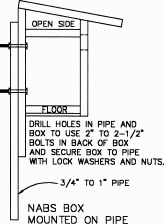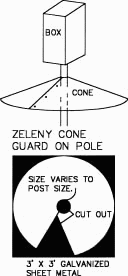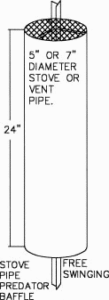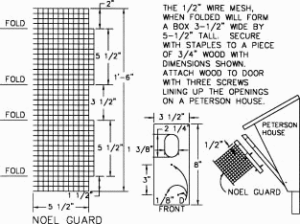Putting up a nest box is a responsibility that should not be taken lightly. When you put up a box, a commitment is made to provide as safe as possible place for the bluebirds to raise their young. If this commitment is taken seriously, both you and the bluebirds will be rewarded.
Bluebirding is a great hands-on project but, from time to time, problems may arise on your trail. Common problems on a bluebird trail include the weather, house sparrows, house wrens, and predators such as raccoons. We cannot control the weather, and sparrows and wrens may prove to be difficult, but losses due to raccoons can and should be controlled. Proper box placement can be a factor in raccoon predation. Boxes placed in pastureland are less likely to attract raccoons than boxes placed near a wooded area with a stream, pond, or lake nearby.
There are two definite lines of defense against raccoons. The best way is to keep the raccoon off the box. The second is to prevent the raccoon from reaching into the box once it gets in a position to try.
There are many ways to predator-proof a box. Here are some methods used by experienced bluebirders.
MOUNTING SYSTEMS
The easiest way to mount a bluebird box would be to nail it to a wooden fence post or to a tree. Although this may work well in certain parts of North America where there are few raccoons, it is generally not recommended. Raccoons climb trees and walk fence lines where they may eventuall
y find your box. Taking the time to properly mount your boxes, may take care of your raccoon problems.

A smooth clean pipe is the best mounting system to use. A 10 foot piece of
3/4 inch EMT electrical conduit pipe can be purchased for a reasonable price. It will then need to be cut down to a length of approximately 8 feet, to place 2 feet of pipe in the ground and 6 feet of pipe above. The electrical conduit is zinc plated and will keep its slick surface for many years. Other heavy round pipe will also work well. Scrap pipe found at construction sites and salvage yards can also be used. An excellent source of pipe is from overhead garage door companies. In their scrap piles from discarded doors you will find either an 8 foot or 16 foot piece of 1 inch pipe.
Most businesses will be glad to give them to you. If they are rusty, they should be sanded smooth. Flattening the bottom of the pipe with a heavy hammer will help stabilize the pipe and keep it from turning. A fence post driver is recommended over a heavy hammer for putting the pipe in the ground. There are several easy ways to mount a bluebird box to the pole:
Pre-drill two 5/16 inch holes through both the conduit or pipe and the back of the box. Use 1/4 inch bolts for anchoring the box to the pole. The drilling can be done before placement in the field.
OR
Wrap two pieces of pipe strap around the pole and screw into the back of the box on either side of the pole. Secure another small piece of pipe strap to the back top and bend it down into the pole to keep the box from turning.
OR
Place two electrical conduit hangers around the pole and screw into the box.

A method that works well for mounting lightweight boxes (i.e., PVC boxes) is the use of a 5 foot piece of 1/2 inch electrical conduit slipped over a 5 foot piece of rebar driven approximately 2 feet into the ground. A conduit connector (with a longer bottom screw) at the base is used to keep the conduit from turning.
A bluebird box may also be mounted on PVC pipe. Some 2 inch PVC pipe will slip over a metal T-post, which makes a secure system when your box is located in a pasture with cattle. Mount your box high enough on the PVC so that the cattle will not have any sharp corners to rub against.
Down spouts can also be used. A 10 foot length of down spout can be cut into three 3 foot 4 inch pieces, which is attached to the back of the box. This can then be slipped over a metal T-post.
By using the above methods, raccoon predation will be greatly minimized. For added protection, substances can be applied to the pole. Rub the pole down will steel wool and apply a layer of Carnauba car wax or silicone spray. Another effective method is to apply a coating of high quality automotive grease to the pole. A mixture of 5 pounds of grease and one quart of turpentine will keep the grease soft throughout the season. Grease will eventually attract dirt and harden which may make it easier for a raccoon to climb the pole. The grease may have to be removed and reapplied if this happens. This is extra work, but it is the most effective way to keep raccoons off the pole.
POLE GUARDS

Some bluebirders prefer using a guard on the pole or post their box is mounted on. Guards that have proved to be successful include:
PVC Baffle
Material List: 4 inch thin wall PVC at least 2 feet long, 4 inch PVC cap, a few screws, a conduit hanger or a hose clamp.
The baffle must be free swinging on the pipe and must wobble when the raccoon tries to climb it. The hole drilled in the top of the PVC cap, should be approximately 1/8 inch larger than the pipe itself. This will keep mice from climbing up the pole and will still allow it to wobble. An oversized hose clamp is recommended in order to give the PVC added “wobble”.
Cones

Material List: 3 foot diameter circle of 24- or 26-gauge galvanized sheet metal, 1/4 inch round head stove bolts, 2 hanger iron straps. Disc blades also work well and can easily be
found at farm auctions. Many excellent baffles are sold at local bird stores which include all the parts and instructions for easy mounting.
Sheet metal wrapped around a wooden post is also recommended. The sheet metal should extend down at least 3 feet below the bottom of the
box, rather than from the ground up.
Stove Pipe

Material List: Galvanized stove or vent pipe 5-7 inch diameter x 24 inch long, 8 inch circle of 1/2 inch hardware cloth, 2 hanger iron straps 7 inches long, 2 No. 8 B32 x 3/4 inch machine screws and nuts.
Entrance Hole Guards
Noel Guard

This guard is estimated to be 90% effective in keeping raccoons or cats from reaching into the box once they have gained access to it. A rectangle of 1/2 inch hardware cloth placed around the entrance hole will stop these predators from reaching down into the nest box. Some bluebirders recommend that the guard not be placed on the box until after the bluebirds have started their clutch, while others have had success leaving the guard on the box year round. This guard is available through NABS.
Wooden Hole Guard
These are no longer recommended by NABS. This is an extra block of wood placed over the nest box entrance, with a corresponding hole in its center. This extra 3/4 inch thickness makes it more difficult for the raccoon to reach in, but unless a very deep box is used, they are still able to reach the nest.
Similar preventative methods apply to snakes and cats. Snakes can climb smooth poles, even greased ones. Snakes are more of a common problem in the southern states but some snake problems may occur all across North America. The stove pipe and cone guards are effective for snake control. Also effective is a 24 inch piece of hardware cloth placed directly under the box.
Both domestic and feral cats pose a threat to bluebirds. The hanging guards mentioned may detour a cat but they may jump as high as 6 feet. If cats are in your area, place your box as high as possible on a smooth pole.
Please do not let the possibility of predation problems discourage you from putting up a bluebird box. Mounting your box on a smooth round pipe will greatly reduce the chance of a loss to a predator. Any other preventative measures taken will provide added protection.
Copyright © 1999 North American Bluebird Society All Rights Reserved
